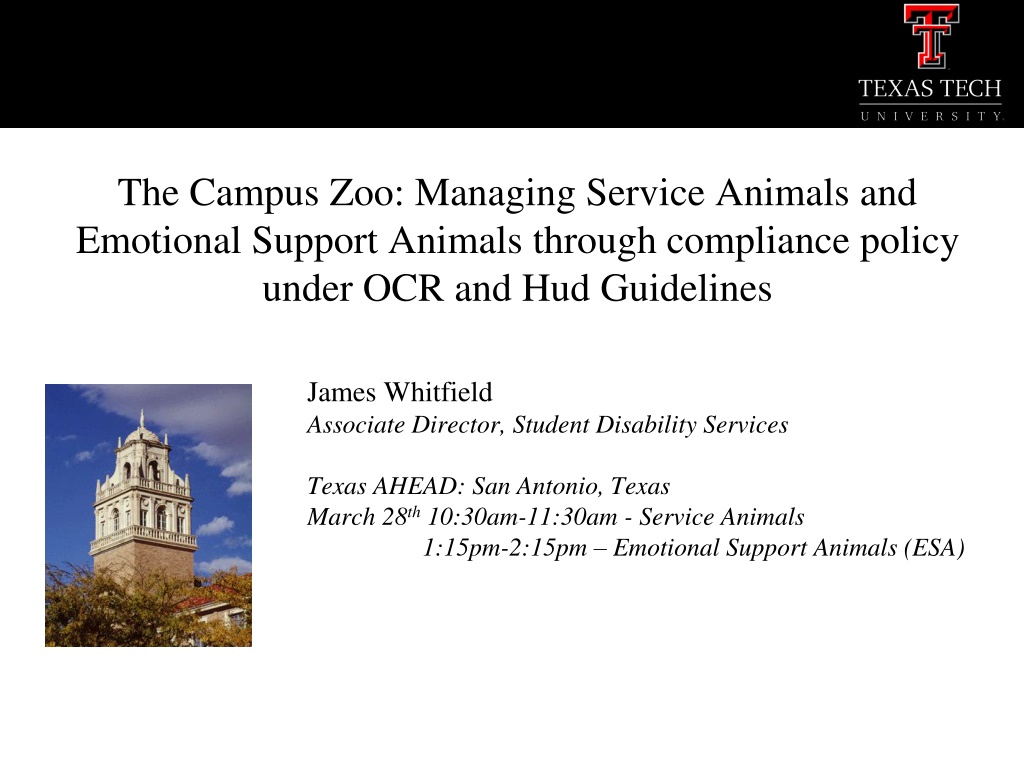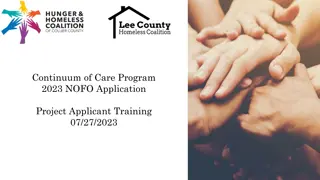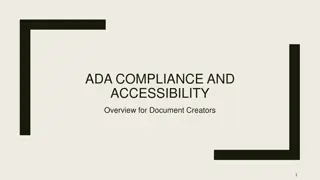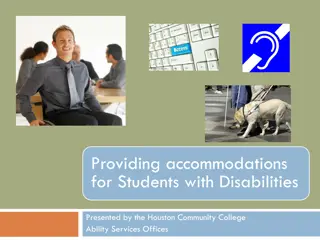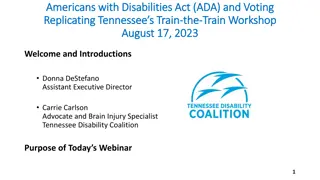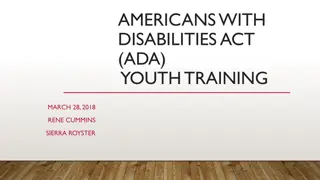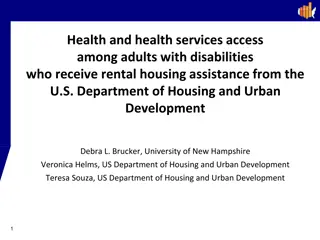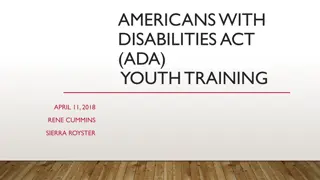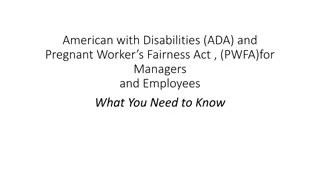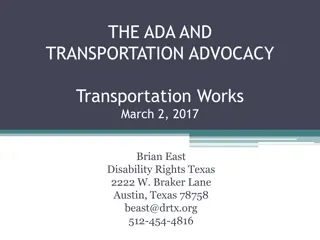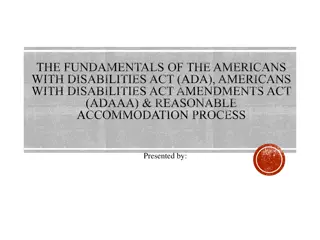Managing Service Animals and Emotional Support Animals in Compliance with ADA and HUD Guidelines
This presentation by James Whitfield explores the management of service animals and emotional support animals on campus under OCR and HUD guidelines. The session covers defining service animals, identifying them in training, recognizing emotional support animals, and understanding the distinctions between them. It emphasizes the legal aspects of service animal accommodations and provides insights into the ADA requirements, including the need for service animals and handling documentation. Practical guidance is offered on interacting with individuals utilizing service animals to ensure compliance with regulations.
Download Presentation

Please find below an Image/Link to download the presentation.
The content on the website is provided AS IS for your information and personal use only. It may not be sold, licensed, or shared on other websites without obtaining consent from the author. Download presentation by click this link. If you encounter any issues during the download, it is possible that the publisher has removed the file from their server.
E N D
Presentation Transcript
The Campus Zoo: Managing Service Animals and Emotional Support Animals through compliance policy under OCR and Hud Guidelines James Whitfield Associate Director, Student Disability Services Texas AHEAD: San Antonio, Texas March 28th10:30am-11:30am - Service Animals 1:15pm-2:15pm Emotional Support Animals (ESA)
Todays Objectives 1. Clearly Identify a Service Animal 2. Clearly Identify a Service Animal in Training 3. Clearly identify an Emotional Support Animal 4. Understand the differences between all three
Service Animal Definitions Definition: Under the ADA, a service animal is defined as a dog that has been individually trained to do work or perform tasks for an individual with a disability. The task(s) performed by the dog must be directly related to the person s disability. Definition of a task The dog must be trained to take a specific action when needed to assist the person with a disability. For example, a person with diabetes may have a dog that is trained to alert him when his blood sugar reaches high or low levels. A person with depression may have a dog that is trained to remind her to take her medication. Or, a person who has epilepsy may have a dog that is trained to detect the onset of a seizure and then help the person remain safe during the seizure.
Need for Service Animals Remember, the need for a Service Animal may not be visibly obvious! If the need is obvious, such as for a blind person needing it for guidance, then you may not ask any questions of the student or restrict their activity. If the need for the Service Animal is not obvious, you may ask two questions of the individual: 1. Do you have the animal because of a disability? 2. What TASK is it trained to do? If they answer yes and give you a specific task, that is all the information that you can legally ask for. If they state it is in training, it may be removed. Service Animals in training are NOT service animals.
Service Animals and the ADA The ADA does not require that service animals be certified as service animals! Covered entities may not require documentation, such as proof that the animal has been certified, trained, or licensed as a service animal, as a condition for entry. Staff are not allowed to request any documentation for the dog, require that the dog demonstrate its task, or inquire about the nature of the person s disability.
Service Animals Other Regulations Other Important Regulations! 1. The ADA does not require service animals to wear a vest, ID tag, or specific harness identifying them as a Service Animal. 2. People with disabilities have the right to train the dog themselves and are not required to use a professional service dog training program. 3. Individuals who have service animals are not exempt from local animal control or public health requirements. Service animals are subject to local dog licensing and registration requirements. 4. Mandatory registration of service animals is not permissible under the ADA. Colleges and other entities, such as local governments, may offer voluntary registries. Many communities maintain a voluntary registry that serves a public purpose, for example, to ensure that emergency staff know to look for service animals during an emergency evacuation process.
Service Animals More Regulations More Important Regulations: 1. The ADA requires that service animals be under the control of the handler at all times. 2. The service animal must be harnessed, leashed, or tethered while in public places unless these devices interfere with the service animal s work or the person s disability prevents use of these devices. In that case, the person must use voice, signal, or other effective means to maintain control of the animal. Examples: 1. A person who uses a wheelchair may use a long, retractable leash to allow her service animal to pick up or retrieve items. She may not allow the dog to wander away from her and must maintain control of the dog, even if it is retrieving an item at a distance from her.
Service Animal Example Another Example: a returning veteran who has PTSD and has great difficulty entering unfamiliar spaces may have a dog that is trained to enter a space, check to see that no threats are there, and come back and signal that it is safe to enter. The dog must be off leash to do its job, but must be leashed all other times. If a service animal is out of control and the handler does not take effective action to control it, or if it is not housebroken, you may request that the animal be removed from the premises. Service Animals must be allowed access to any areas that are available to the general public, including academic buildings on campus.
Service Animals at Texas Tech University Operating Policy at TTU recognizes the Service Animal as an extension of the student and thus is under the same code of conduct as its handler. Faculty members may ask students with Service Animals to leave a classroom for being disruptive just as they would ask a student to do so for the same reasons. Students may return to the classroom without the Service Animal
Service Animals in Labs and Clinics Under guidance from the Department of Justice and the Center for Disease Control Service animals are considered no more of a health risk than a human. Therefore, unless there is a requirement for face coverings and foot coverings, service animals must be allowed into any setting people are permitted into.
Service Animals in Dining & Residence Hall Facilities This is the same guiding principle that allows Service Animals into: 1. All dining and food facilities on campus. 2. Bathrooms and common living areas. 3. Lobbies and recreation facilities.
Student Procedures for Registering a Service Animal Step 1: Complete Student Disability Services Application. Step 2: Complete the Housing Request Form and submit for approval Step 3: Meet with Student Disability Services Counselor (James Whitfield/ Raquel Iber) to approve the application. Step 4: SDS notification to Housing upon completing approval meeting with SDS Step 5: Housing will contact student by email to complete additional implementation steps (Service Animal form , room-mate agreement form and Information sheet) Step 6: Once all documentation is complete, Housing will notify student by email
Texas State Law Regarding Service Animals in Training Texas State Law does allow for Service Animals in training to access areas generally accessible to the general public AS LONG AS they are accompanied by an approved trainer. Must still meet all of the other regulations in place for trained Service Animals.
What Constitutes an Approved Trainer? Good Question! Current statutes do not define what an approved trainer is. Previous language indicated that it was a person who is a member of professional organization generally recognized as training dogs to be their primary mission . Language was removed from state website when DARS was merged into Workforce Commission.
Texas Tech System Wording An approved trainer is an individual who is certified by a state organization whose primary mission is to train animals for the purpose of assisting individuals with disabilities
Key Provisions of the Texas State Law Your Rights: *To enter with your trained service animal all places where members of the public are normally free to enter Public Transportation (at no extra cost) College dormitory and educational facilities Businesses Restaurants or other places where food is for sale Medical facilities, including clinics, exam rooms, hospital cafeterias,
Additional Keys to Texas State Law Housing It is your right to full and equal access to housing accommodations. You are exempt from pet deposits and any policies against owning animals. An exception to this rule is made for single-family residences where only one room is rented, leased or furnished. Inquiries It is your right to not be asked about your service animal s qualifications or certifications when attempting to enter a public place. Representatives of a public facility may ask you about the basic type of assistance the service animal provides you.
Penalty Provisions of Texas State Law Penalties for Violating Service Animal Laws Discrimination Denying entry or service to a person with a disability who uses a service animal is discrimination and a: Misdemeanor crime punishable by a fine of not more than $300 and 30 hours of community service Violation of civil liberties that warrants a cause of action for damages in court if there is a presumption of damages to the person Fraudulent Use of Service Animals Representing an untrained animal as a trained service animal is a misdemeanor punishable by a fine of not more than $300 and 30 hours of community service.
Questions and Concerns about Service Animals? Student Disability Services Texas Tech University Box 45007 130 Weeks Hall Lubbock, Texas 79409-5007 (806) 742-2405 james.whitfield@ttu.edu sds@ttu.edu Instagram / Twitter: @TTU_SDS
What is an Emotional Support Animal? An emotional support animal is an animal companion that offers some type of benefit to an individual with some form of disability. The animal is intended to provide companionship and support that will help alleviate at least one aspect of the disability. Provide: Anxiety relief Trauma support Reciprocal love and support
Emotional Support Animals and the ADA Emotional Support Animals are NOT considered service animals under the ADA. These terms are used to describe animals that provide comfort just by being with a person. Because they have not been trained to perform a specific job or task, they do not qualify as service animals under the ADA. However, some State or local governments have laws that allow people to take emotional support animals into public places. They ARE however, covered under the Fair Housing Act as a reasonable accommodation.
Legal Precedent for Emotional Support Animals Legal Precedent U.S vs University of Nebraska at Kearney (2011) Key points of the ruling: 1. Campus housing on a public institution is subject to the Fair Housing Act 2. Cited HUD rules that necessitate the accommodation of an ESA for full enjoyment and use of the dwelling. 3. UNK case also established the requirement that institutions have a process in place for processing requests for ESA s.
Student Process for Registering an ESA Step 1: Complete Student Disability Services Application Step 2: Complete the Housing Accommodation Request Form and submit for acceptance to the SDS office Step 3: Meet with Student Disability Services Counselor (James Whitfield/ Raquel Iber) for approval of an ESA Step 4: SDS sends notification of ESA approval to Housing upon completing the approval meeting Step 5: Housing will contact student by email to complete additional procedural information (ESA Procedure form, room-mate agreement form and Information sheet) Step 6: Once all documentation is complete, Housing will notify student by email the process has been completed and animal is registered.
Emotional Support Animal Eligibility Requirements for eligibility for an ESA: Documentation from a qualified mental health professional clearly stating the need for the ESA. Documentation from an online website is generally not acceptable and is not recognized by HUD or DOJ. Not sufficient to establish an individual has a non-observable disability or a disability-related need for an ESA. Tele-health assessments are recognized. A reliable form of documentation is a note from a person s health provider that confirms a person s need for an ESA and the provider has personal knowledge of the individual.
Documentation Guidelines Documentation does not require a specific diagnosis of a disability, but should tie the need for an ESA to the disability itself. Needs to follow published SDS guidelines for documentation: 1. On official letterhead. 2. Completed by a licensed mental health professional. 3. Completed or updated within the past year
General HUD Guidelines for ESAs A housing provider may not charge a fee for processing the ESA request A housing provider may not charge a pet fee or deposit. They can charge for damage. A reasonable accommodation may include alterations to a HOA rule, or zoning laws Entities are not required to provided an ESA accommodation if it constitutes a direct threat to other tenants and/or property damage.
Which Animals can be ESAs? Based on guidance from HUD in 2020: Dog, cat, small bird, rabbit, hamster, gerbil, other rodent, fish, turtle, or other small, domesticated animal that is traditionally kept in the home for pleasure. Reptiles (except turtles), barnyard animals, monkeys, kangaroos, and other non- domesticated animals are not considered common household pets. No snakes!!
Unique Emotional Support Animals Animal not commonly kept as a household pet. Requestor has substantial burden of proof of a disability-related therapeutic need for the specific animal or specific type of animal. ESA s should be in compliance with community ordinances for pets. Any animal that is not allowed within a community due to city health ordinances, typically wild animals, would not normally be eligible as an ESA. (Ex., Skunks, Racoons, Opossums)
Unique ESA Examples Examples: The animal is individually trained to do work or perform a task that cannot be performed by a dog. (capuchin monkey) Allergies prevent the person from using a dog. The individual seeks to keep the animal outdoors at a house with a fenced yard where the animal can be appropriately maintained. (donkey)
How Many ESAs Can a Student Have? In general, a student is entitled to a single ESA. However, in some cases a student may request two ESA s. A request for more than one ESA needs to be supported by clear documentation from the mental health provider stating specifically the reasoning for needing more than one. If more than one is supported by documentation, then size of the ESA has to be considered.
Emotional Support Animal Restrictions Where can ESA s be taken? 1.Restricted to the immediate living area of the student. 2.May NOT be taken into common living areas, such as community bathrooms, kitchens, and study areas. 3.May not be taken into any other buildings on campus for any reason.
ESA Student Responsibilities Students with both ESA s and Service Animals are fully responsible for their maintenance, including care, feeding, and all required vaccinations when applicable. Students are fully responsible for cleaning up any areas where their animals relieve themselves on campus property. Students are also fully responsible for any damage caused by the ESA or Service Animal on campus.
Essentials for Written Policy Published with clear guidelines for application and documentation requirements. Reference HUD guidance from 2020. Reference local community standards for pets Have forms available to be filled out by the treating professional with essential information. Providers do not have to use the form, but must still provide the required information.
More Policy Guidelines TTU has clearly defined procedures for maintaining/caring for ESA s in the residence halls. Expectations for ALL animal care. Process for removing ESA s for health reasons Process in place for how fines will be assessed for damage.
Addressing Non-Approved Animals Should Housing staff discover an animal in the Residence Halls that has NOT been approved, the student should be given notice that they are in potential violation of the No Pet policy. If the student then claims it is either an ESA or a Service Animal, they have 10 days from the notice to either submit current documentation for the animal, or provide proof of a scheduled appointment with a mental health provider to secure necessary documentation.
A Comparison of Service Animals and ESAs Side by Side Comparison Review: Service Animal ESA A Dog Common Household Pets, including dogs and cats Trained to do a task Not trained, is just present for comfort Permitted anywhere on campus Only permitted in the immediate living area
Scenario 1 At a baseball game, a family is in attendance with a large dog that is wandering around the stadium, licking other patrons and being generally friendly. However, after a complaint you ask the family if this is a service animal and they say yes, its for their daughter s anxiety and it is their right to have it there. What do you do?
Scenario 2 A student has requested an ESA for their residence hall room. The student cites that the request is for a cat but once they arrive to the dorm, it is a large tarantula. What do you do?
Scenario 3 Student brings a dog to classroom, holding the dog in her arms and as she sits the dog remains in her lap. She claims this is her service animal. What do you do?
Scenario 4 A student brings their service animal, which is a 60 pound pitbull, explains that this is their service animal. They answer the questions, yes the dog is for my disability, and the dog makes me feel better. What do you do?
Scenario 5 You have a student who brings a service animal on to campus on it s leash, but several times a day they take it to the middle of campus, unleash it and let it run and chase squirrles for awhile as its reward. When it does, it also relieves itself on the grass. What do you do?
Scenario 6 A student goes to a chain pet center and purchases a 6 week old puppy and presents a certificate from the pet chain that states that this is their emotional support animal. What would you do?
Scenario 7 A student has requested an ESA for their residence hall. The request is for two sugar gliders, because they feel like they are happier in pairs. What do you do?
Scenario 8 After an individual brings their dog to the residence hall, it was found that the student has not completed the Housing Accommodation Request and has not been approved through the SDS office. What do you do?
Scenario 9 A student brings their dog to the recreational fields, which has a no pet policy. They claim it is a service animal. However, when the soccer game begins, they tie the dog up to a pole and leave it there while they go and play. What do you do?
Scenario 10 A student takes their service animal into the biology building because they are about to take an exam and wants it with them to reduce their anxiety. The animal is on a leash as required, but it is a cat. What do you do?
